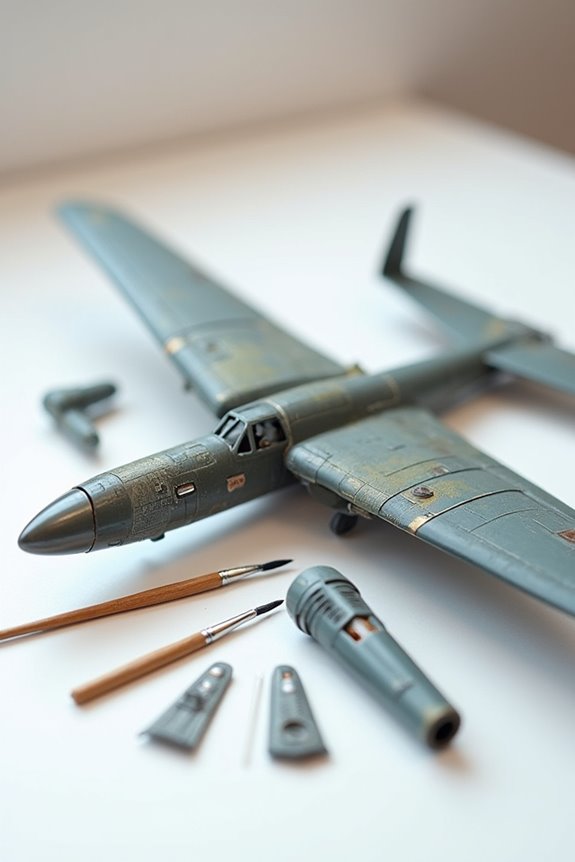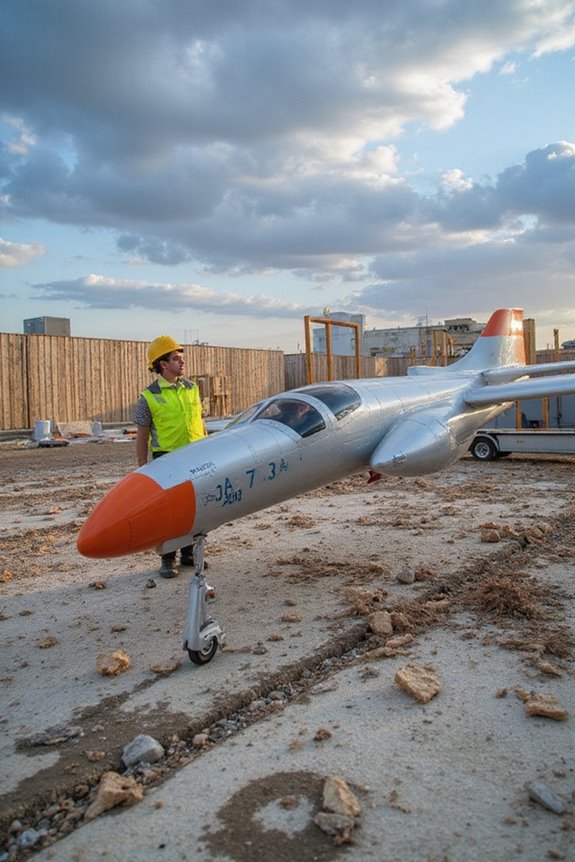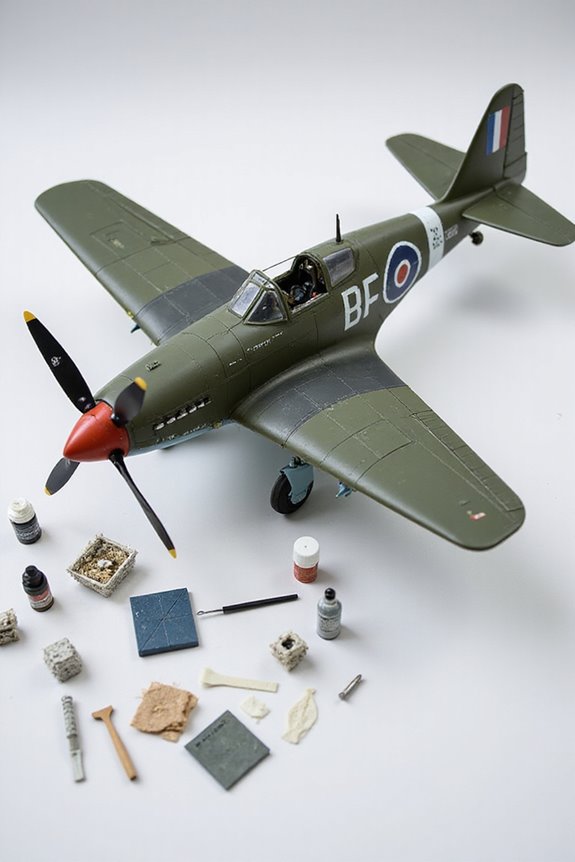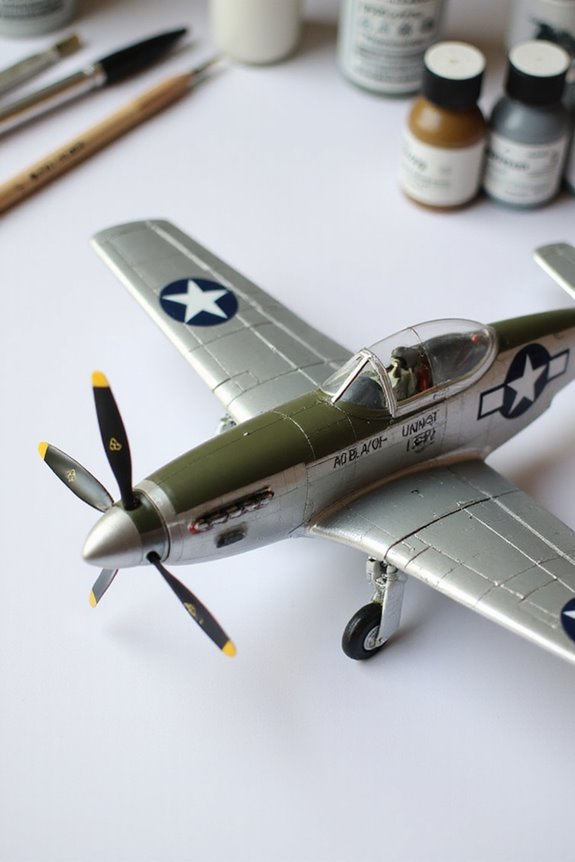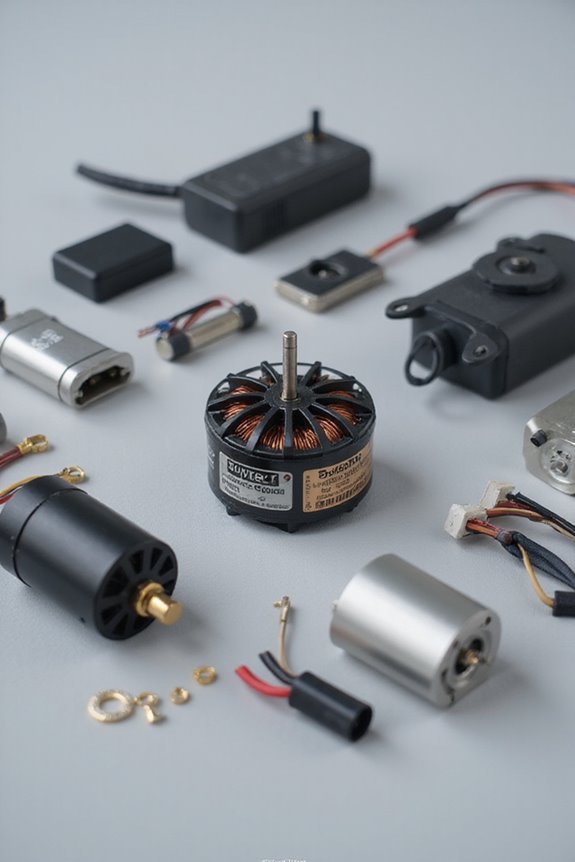Building a model aircraft on a budget is totally doable! Start by picking a high-wing trainer for stability and easy assembly. We can use lightweight materials like foam or Depron for the wings, which are crash-resistant. Opt for affordable electronics like the Xiao ESP32 C3 microcontroller and brushless motors for better performance. Don’t forget to keep things simple; a well-structured design leads to delightful flying. Stick with us, and you’ll discover even more tips for your build!
Key Takeaways
- Choose high-wing trainers or RTF models for stability, ease of assembly, and to minimize extra costs.
- Utilize affordable materials like thermocol, Depron sheets, and repurposed components to reduce expenses.
- Stick to simplified designs that calculate stress points, ensuring structural integrity without overwhelming complexity.
- Opt for budget-friendly electronics, using compatible transmitters and efficient brushless motors for performance.
- Finish with lightweight fiberglass and waterproof adhesives to enhance durability without adding unnecessary weight.
Choosing the Right Model and Design
So, how do we choose the right model and design for our budget-friendly aircraft creation? First, we need to evaluate model types. Let’s look at high-wing trainers for their stability. They’re forgiving and easy to assemble—perfect for beginners!
Next, think about design features. Ready-to-fly (RTF) models are ideal since they come with everything we need, reducing extra purchases. And hey, who wants to spend hours assembling when we could be flying?
If we’re feeling crafty, plastic scale kits offer simplicity without overwhelming us. Foam construction is lightweight and crash-resistant too, making it a great choice for those nervous first flights. Additionally, consider models with advanced stabilization systems to improve flight stability, especially for beginners. Remember, with the right model and design, we can soar without breaking the bank!
Sourcing Materials and Components
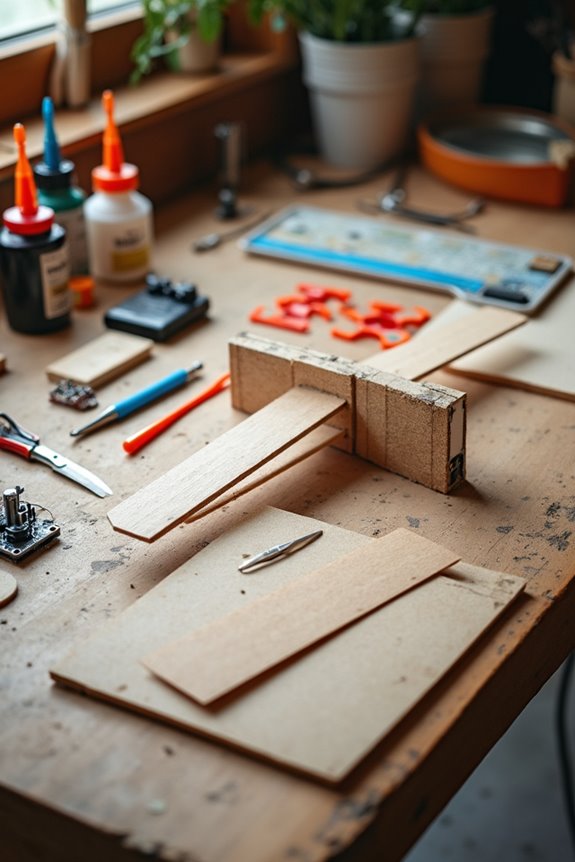
Once we’ve picked the right model and design, it’s time to gather our materials and components. First up, let’s talk about sourcing electronics. We’re looking at affordable options like the Xiao ESP32 C3 microcontroller for control systems and the DRV 8833 for motor control.
Next, while selecting materials, thermocol and Depron sheets make great wings. And don’t forget plywood for structural support! Additionally, consider using high-grade natural wood for enhanced durability and a more authentic build.
When it comes to choosing tools, a simple craft knife and a soldering iron become our best friends.
Lastly, we can save a few bucks by repurposing components. Think old clock mechanisms for actuators or refashioning PVC cards for control surfaces. Let’s get creative and build something amazing without breaking the bank!
Effective Construction Techniques
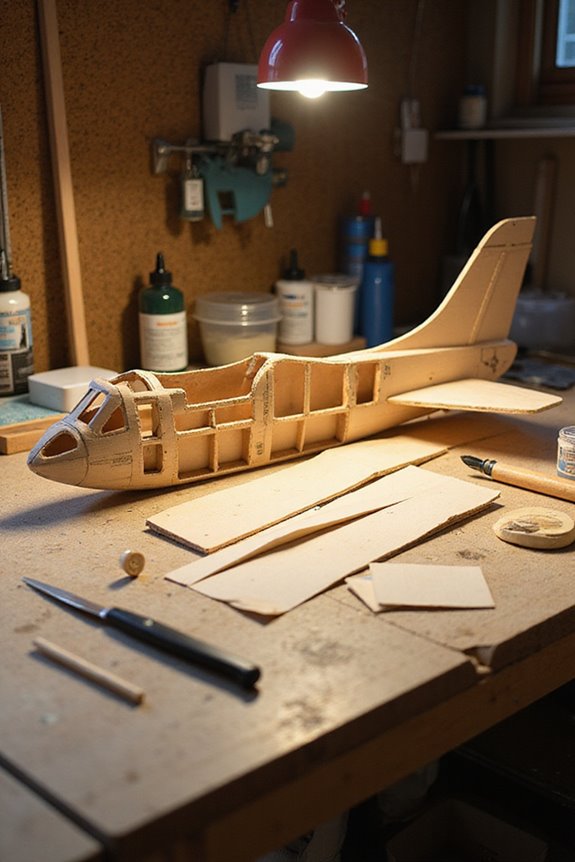
When it comes to building model aircraft, effective construction techniques can make or break our project. Using stick balsa for our frameworks is a wonderful way to keep things light and easy. It’s like building with toothpicks, but way cooler!
Next, we should focus on structural design. It’s not just a fancy term; we need to calculate stress points and reinforce them to withstand flight. Think of it as making a sandwich—if the bread’s weak, our delicious filling might flop!
Don’t forget about cost-saving tricks too. Simplifying designs and using basic tools can help us build without breaking the bank. Additionally, high-quality materials can significantly enhance the durability and performance of our model aircraft. And remember, a well-built aircraft will not only save us money but also make flying way more fun!
Electronics Selection and Installation
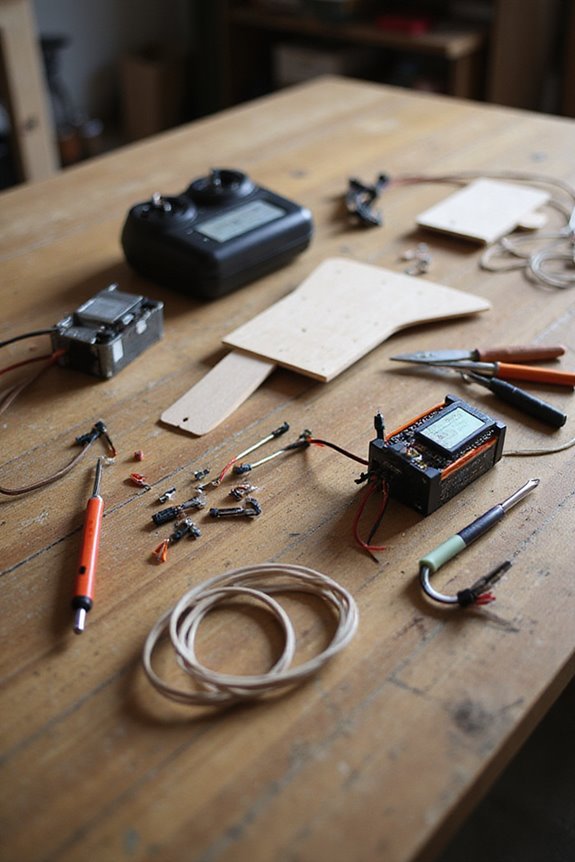
Choosing the right electronics for our model aircraft can be a bit like picking out the perfect toppings for a pizza—everything needs to work together seamlessly! First, let’s chat about transmitter selection; make sure our receiver is compatible with it, especially if we choose budget options.
Now, let’s focus on motor efficiency—a brushless motor might cost a little more, but it’ll save us in the long run with better performance. Additionally, consider integrating a nitro engine for enhanced power and performance if your budget allows for it.
When it comes to ESC placement, keeping it cool is key for longevity. For battery capacity, we really want to choose wisely; a higher capacity offers longer flights. Finally, let’s practice good power management. That way, our aircraft can soar beautifully without crashing as quickly as that poorly made pizza!
Budget-Friendly Finishing and Customization
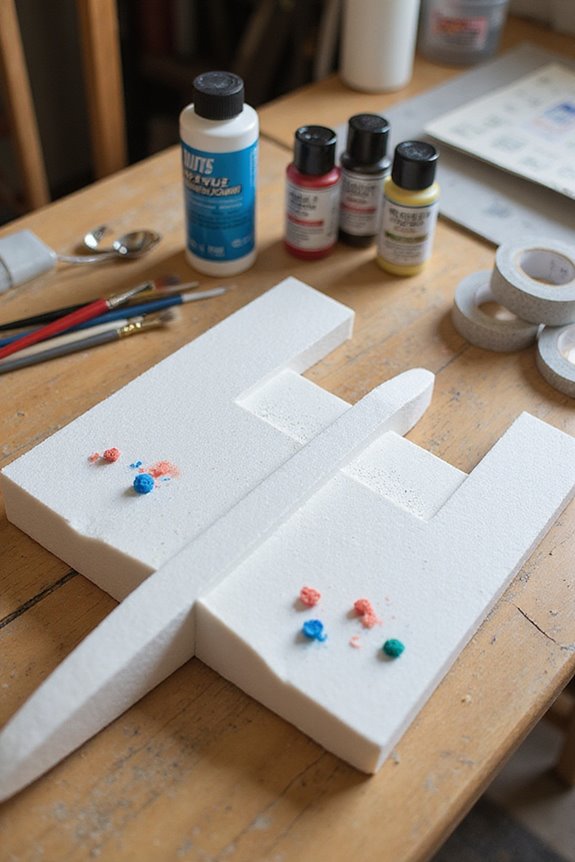
As we plunge into the world of finishing and customization, it can feel like icing a cake—too much could ruin the whole thing! Using lightweight fiberglass cloth can give our model durability without weighing it down. We selectively focus on high-wear areas, applying techniques that maintain precision.
For those canopies, let’s embrace budget-friendly canopy polishing. Cleaning them with isopropyl alcohol prevents scratches. Then, we can use homemade masking for those tricky curves. Sanding with fine materials enhances transparency, and a quick buff with Tamiya compound works wonders!
Additionally, utilizing waterproof characteristics in our chosen adhesives will ensure that our models withstand the elements and maintain their structural integrity.
Just remember, when we finish, we’re not just covering; we’re enhancing the beauty and flight of our creations—but not with extra weight!
Strategies for Staying Within Budget
Finishing our model is just one piece of the puzzle; staying within budget is another. We can kickstart our journey with affordable materials like foam board, which costs just $1–$2 per sheet. Why pay more for fancy kits when thousands of free plans await us online? Let’s get clever with recycled materials, too!
As for electronics, let’s stick to budget-friendly motor and servo combos recommended for newbies. No need to splurge on extras that only complicate things. Additionally, opting for lightweight EPP foam can enhance durability while keeping costs down.
Finally, let’s leverage community resources—join forums for tips and engage with local RC clubs. Together, we can swap materials, borrow tools, and gather priceless advice. With these cost-saving strategies, our aircraft will fly high while our wallets remain happy!
Frequently Asked Questions
What Is the Best Beginner Model Aircraft to Start With?
For beginners, we should consider electric planes and glider kits. They offer simple assembly and enjoyable flying experiences, making them perfect choices that balance fun, ease, and impressive final results for newcomers in modeling.
How Do I Find Local Flying Clubs or Communities?
To find local flying clubs, we can connect with fellow local hobbyists through community events and social media. Visiting hobby stores also helps us locate nearby clubs and meet other enthusiasts enthusiastic to share experiences.
Can I Fly My Model Aircraft Indoors?
Absolutely, we can fly our model aircraft indoors! Just remember, aircraft size is essential—we’ll need lightweight designs. With spacious areas and proper precautions, indoor flying can be a fantastic experience for all of us!
What Are the Local Regulations for Flying Model Aircraft?
Maneuvering the sky is thrilling, but we must respect local laws and flight restrictions. Knowing these regulations guarantees our adventurous spirits soar safely. Let’s check local ordinances before we take our model aircraft to the skies!
How Do I Safely Transport My Model Aircraft?
When we’re transporting our model aircraft, let’s consider safety tips like using custom foam padding and sturdy containers. We’ll explore effective transport methods to guarantee our models arrive intact and ready for flight.

